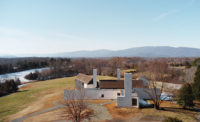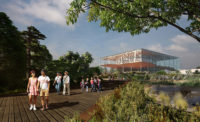Bullas, Spain
Project Size: 4,582 square feet
Site Size: 8 acres
Program: Three sisters with their own families requested separate dwellings to be placed in close proximity to each other in southeast Spain. They wanted the architecture to blend in with the surrounding vineyards and olive groves and be constructed of local, natural materials. Although the region is prone to hot summers and cold winters, the clients asked for passive heating and cooling strategies where possible.
Solution: Blancafort-Reus Arquitectura designed a pinwheel plan with freestanding structures arranged around a communal courtyard. The three two-story units, constructed of masonry walls with concrete columns and slabs, are clad in pressure-treated local pine planks that give the entire complex a raw, unvarnished look.
The three houses are practically identical, with each containing a living, kitchen, and dining area on the main level and a master suite above. Yet each diverges from the other by virtue of extra bedrooms, office space, or extended living areas. To get from one to another, residents use outdoor circulation spaces delineated by wood fences.
The architects employed a number of sustainable design strategies: solar panels, rainwater collection for irrigation of trees and vegetable gardens, concrete floors, and windows with insulated shutters. Construction of the entire complex cost $444,000.
People
Architect:
Personnel in architect's firm who should receive special credit:
General contractor:
Photographer:
CAD system, project management, or other software used: |
Products
Structural system:
Exterior cladding:
Masonry:
Wood:
Fa'ade (from interior to exterior):
Roofing:
Other:
Windows:
Glazing:
Doors:
Interior finishes: Wall coverings: Plaster
Special surfacing:
Floor and wall tile (cite where used):
Plumbing:
Energy:
• Low emission glass and exterior jalousies minimize heat loss in winter and solar radiation in summer |























Post a comment to this article
Report Abusive Comment